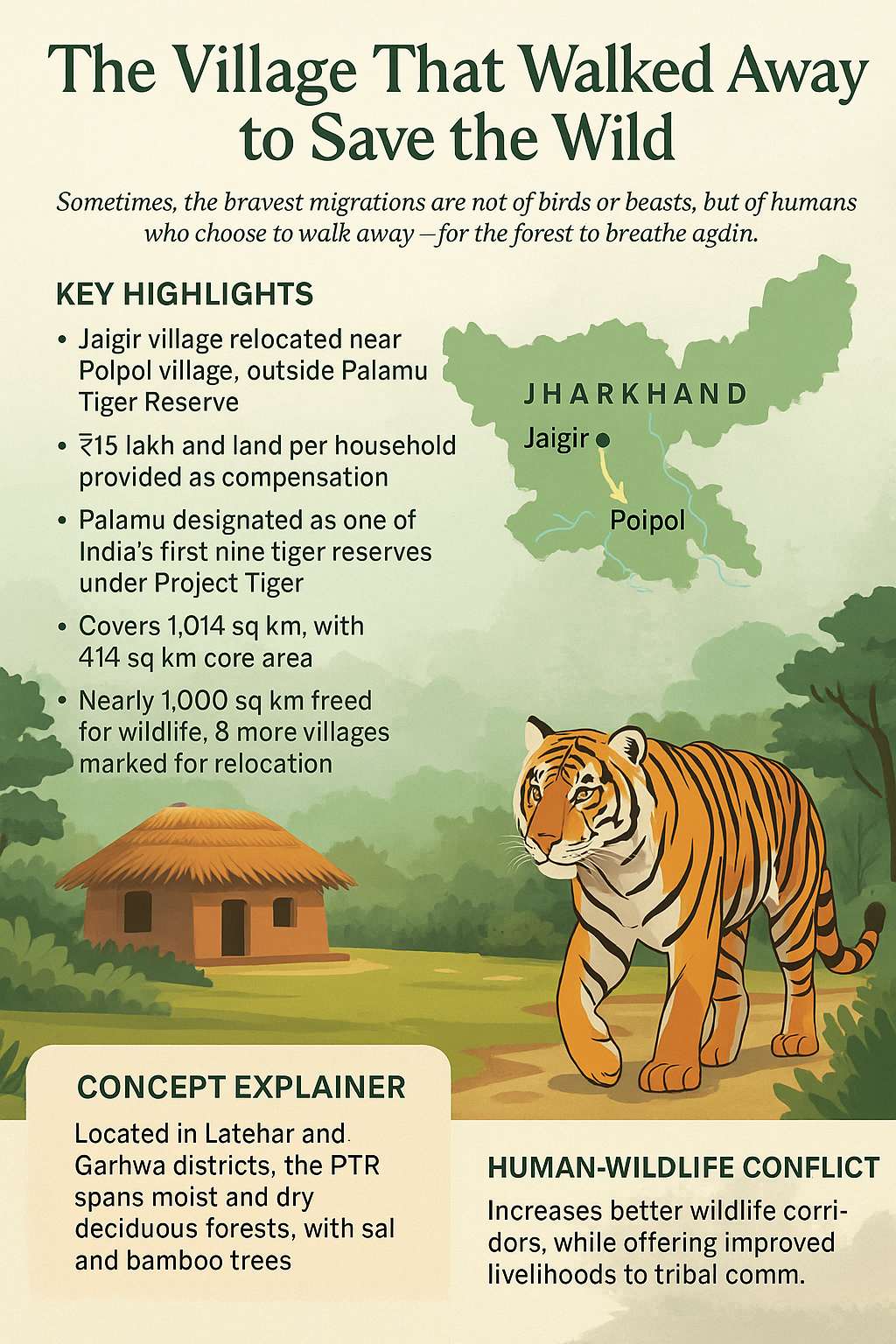
📅 May 3, 2025, Post 7: The Village That Walked Away to Save the Wild |Mains Essay Attached | Target IAS-26 MCQs Attached: A complete Package, Dear Aspirants!
The Village That Walked Away to Save the Wild

NATIONAL HERO — PETAL 007
🗓️ May 3, 2025
THEMATIC FOCUS:
Wildlife Conservation • Habitat Restoration • Tribal Welfare
🪶 Intro Whisper
Sometimes, the bravest migrations are not of birds or beasts, but of humans who choose to walk away—for the forest to breathe again.
🌿 Key Highlights
• Relocation Milestone: Jaigir village becomes the first to be completely relocated outside the core area of Palamu Tiger Reserve (PTR) in Jharkhand.
• New Site: Shifted near Polpol village, offering better infrastructure and access to services.
• Compensation Provided: ₹15 lakh per household + land grant to one member.
• PTR Facts:
– One of India’s first 9 tiger reserves under Project Tiger
– Covers 1,014 sq km with 414 sq km core area
– Hosts species like tigers, elephants, sloth bears
• Ecological Benefit: Nearly 1,000 sq km now free from human interference; strengthens tiger corridor and biodiversity zone.
• Future Vision: 8 more villages marked for relocation; Polpol to become model resettlement village.
📜 Concept Explainer
Palamu Tiger Reserve (PTR):
Located in the districts of Latehar and Garhwa in Jharkhand, PTR is a biodiversity-rich zone featuring Sal and bamboo forests. Established in 1973, it was a pioneer in India’s Project Tiger movement. It’s historically notable for conducting the world’s first tiger census in 1932.
Human-Wildlife Conflict:
Villages inside core zones lead to deforestation, poaching, and human-animal conflict. Voluntary relocation ensures better wildlife corridors while offering improved livelihoods to tribal communities. The PTR model offers a harmonious coexistence between conservation and development.
🧭 GS PAPER MAPPING
GS 3: Environment and Ecology
• Project Tiger and Protected Areas
• Human-Wildlife Conflict
• Biodiversity Conservation
GS 2: Governance and Welfare
• Role of State in Rehabilitation
• Tribal and Vulnerable Communities
• Implementation of Sustainable Development Goals (SDGs)
💭 A Thought Spark — by IAS Monk
“The wild will never speak in words. But when we step aside and listen with silence, the forest writes back in the script of rain, grass, and paws.”
High Quality Mains Essay For Practice :
Word Limit 1000-1200
Where the Forest Remembers Us: On Human-Wildlife Conflict and Our Forgotten Wildness
For centuries, humans and wild animals lived side by side—not as separate species occupying distinct realms, but as cohabitants of the same rhythmic wilderness. Long before concrete, carbon, and commerce, we were just another creature—naked to the monsoon winds, guided by scent and instinct. It is this ancient kinship that modern conservation must remember, especially when addressing the increasing tension we now call Human-Wildlife Conflict.
The Conflict: Symptom of Separation
Human-wildlife conflict is no longer a marginal issue—it has become one of the central challenges of biodiversity conservation in the 21st century. As forests shrink and cities expand, the buffer between man and beast thins. Crops are trampled by elephants, cattle fall prey to big cats, and humans retaliate with violence—poisoning, fencing, and fear. Tigers become threats. Leopards are labeled intruders. And yet, the root of this conflict is not the tiger’s paw or the leopard’s leap—it is the severance of man from nature.
The relocation of villages like Jaigir from the core zones of Palamu Tiger Reserve marks an attempt to restore that lost balance. It’s not simply about shifting settlements—it’s about rewriting our relationship with the wild.
Philosophical Underpinning: We Were Once Them
The irony is tender and haunting: once upon a time, humans too were wild animals. We padded barefoot through the same forests, hunted with similar eyes, and bowed to the same seasons. The distance between a tiger’s instinct and a tribal hunter’s mind was never measured in kilometers but in kinship. Civilization, in many ways, has numbed that shared rhythm.
In uprooting entire communities to protect tigers, we must ask—are we also displacing memories of our wilder selves?
Ethics and Ecology: Finding the Balance
True conservation is not merely about fencing forests or counting tigers. It is about listening. Listening to the fears of the farmer whose son was attacked, to the hunger of the elephant that raided crops, to the heartbeat of the forest itself. Ethical relocation programs—such as that of Jaigir—must ensure not just compensation but dignity, community, and opportunity.
The success of such initiatives depends on how well we reconnect livelihood with the landscape. Polpol, the new village site, becomes a hopeful model—not just of relocation, but of co-evolution—a place where development and wildness are no longer enemies.
Ecological Wisdom: Coexistence, Not Conquest
The forest is not a zone to be conquered. It is a breathing manuscript of evolution. We are not its managers—we are its forgotten children. If we are to ensure the survival of tigers, sloth bears, or elephants, we must also allow the forest to breathe through us—through our laws, our lifestyles, our language.
Coexistence must be the new conservation paradigm: creating wildlife corridors, reducing dependency on forest resources, supporting eco-tourism, and embedding ecological awareness in education.
A Return to the Wild Within
Ultimately, human-wildlife conflict is not about the tiger outside—it is about the tiger within. It is about the tension between our primal roots and our polished modernity. We cannot resolve this conflict with guns or fences—we must resolve it with memory.
To conserve the wild is to remember that once, we were wild too.
Quote to Close:
“We did not weave the web of life, we are merely a strand in it. Whatever we do to the web, we do to ourselves.” — Chief Seattle
Target IAS-26: Daily MCQs : May 3, 2025
📌 Prelims Practice MCQs
Topic: Global Financial Reforms and Sustainable Development Goals
MCQ 1 (Type-1: How many statements are correct?)
Q. Which of the following statements regarding the Palamu Tiger Reserve and village relocation efforts are correct?
1. The Palamu Tiger Reserve lies entirely within the state of Odisha and is known for mangrove forests.
2. Jaigir became the first village to be completely relocated outside the core area of the reserve.
3. The relocation of Jaigir aimed to reduce human interference and improve living standards for villagers.
4. The reserve was one of the first to be included under India’s Project Tiger and hosted the first tiger census in 1932.
OPTIONS:
A) Only two
B) Only three
C) All four
D) Only one
🌀 Didn’t get it? Click here (▸) for the Correct Answer & Explanation
✅ Correct Answer: B) Only three
🧠 Explanation:
1. ❌ Incorrect – Palamu is located in Jharkhand, not Odisha, and it features deciduous, not mangrove, forests.
2. ✔️ Correct – Jaigir was the first village relocated outside the core zone.
3. ✔️ Correct – The relocation targeted both habitat restoration and villager welfare.
4. ✔️ Correct – It was one of the first Project Tiger reserves and hosted India’s first tiger census in 1932.
MCQ 2 (Type-2: Two-Statement Based)
Consider the following statements:
1) Relocation of villages from tiger reserves helps reduce human-wildlife conflict and restores animal habitats.
2) All relocated villagers are given permanent jobs in the forest department as part of compensation.
OPTIONS:
A) Only 1 is correct
B) Only 2 is correct
C) Both are correct
D) Neither is correct
🌀 Didn’t get it? Click here (▸) for the Correct Answer & Explanation
✅ Correct Answer: A) Only 1
🧠 Explanation:
• 1) ✔️ Correct – Relocation is a conservation strategy to reclaim habitat and reduce conflict.
• 2) ❌ Incorrect – Compensation includes cash and land, but not guaranteed jobs.


















